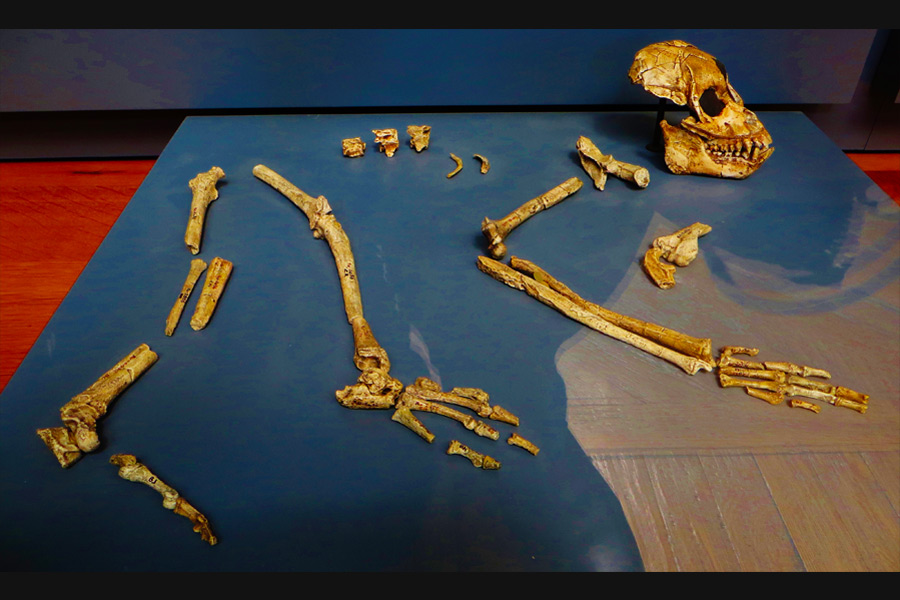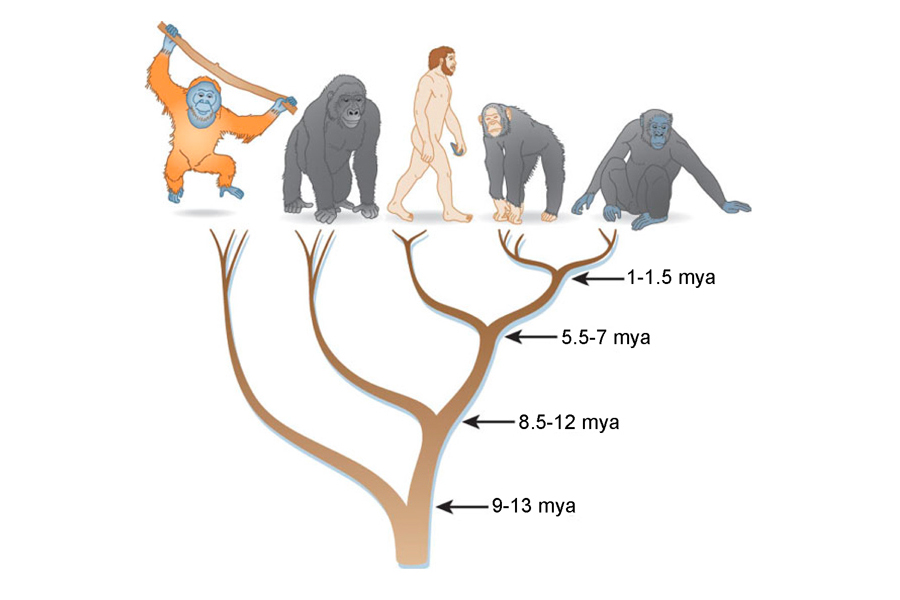If you spend enough time thinking about human evolution, you will eventually ask the question—“if we evolved from chimpanzees, why are there still chimpanzees?” This misconception is easily cleared up: we did not evolve from chimpanzees, but rather from a last common ancestor (LCA) that we shared with chimpanzees some 8.0 to 7.0 million years ago. This LCA was neither chimpanzee nor human, but it was most certainly an ape. Humans belong to the ape branch of the primate family tree, a group called Hominoidea (Figure 1 below). This group is typically subdivided into the great apes (humans, chimpanzees, gorillas, and orangutans) and the lesser apes (gibbons).

Figure 1.
Image credit bioninja.com.au.
Despite the many differences between body size, diet, locomotor style, and social behavior, there is a suite of anatomical and developmental similarities that unite all apes. These features are even found in humans (Figure 2 below) and include tail loss; an upright torso with short, stiff lower back and wide ribcage; flexible joints; a relatively large brain; and a relatively long lifespan.

Figure 2.
Image credit ifunny.co
Convergent Traits
Paleoanthropologists are interested in when these defining ape features evolved and whether they are derived from shared ancestry or are convergent, meaning they appeared independently in multiple lineages. Convergent traits are not useful for reconstructing evolutionary relationships. These features inform how we understand human evolution, including what traits were present in the LCA of humans and chimpanzees. To find the answers, we can’t only look to the traits in the living ape species but will also need to look deeper in time and take a bottom-up approach by examining ape evolution over the last 30 million years.
Miocene world
Today, nonhuman apes are few in number and face dire extinction risks in the face of human-driven impacts like poaching, habitat loss, and climate change. In the Miocene epoch, between 23 to 5.3 million years ago, the world was much less grim for apes. During the majority of time, the Miocene apes were diversifying, inhabiting new environments, and evolving new adaptations. There are only eight ape genera alive today, including our own genus Homo, but as many as 50 genera of fossil ape have been identified in Africa, Europe, and Asia during the Miocene. Given the rarity with which animals are preserved as fossils, these species surely represent a fraction of the true diversity of apes during this time period. It was a veritable planet of the apes!
In the early Miocene, Africa was an island continent where a diverse cohort of ape-like species coexisted in the forests and woodlands of what is now Kenya and Uganda. These early apes were likely the predecessors of the common ancestor of living apes but had evolved only a few of the defining features seen in living apes.
One of the best-known species, Ekembo, had a long and flexible back, narrow ribcage, and restricted joint mobility. These features suggest that this animal was an above-branch quadruped, moving through the trees by climbing cautiously on all fours on top of branches. Despite having a more monkey-like body plan, Ekembo’s lack of tail allows us to recognize it as an early ape. Another species from Kenya, Afropithecus, provides the earliest evidence that an ape-like life history, or pattern of slow growth and development, was present 17 million years ago. These early Miocene species show that the key features of living apes did not appear as a single unit, but evolved in a mosaic fashion, where individual traits appeared at different times within distinct lineages.

Fossil of Ekembo, an extinct mammal (Musee d'Histoire Naturelle, Paris).
Image credit Ekembo: Ghedoghedo, CC BY-SA 3.0 via Wikimedia Commons
Ape migration
By 17 million years ago, a land bridge formed between Africa and the Arabian Peninsula. This created a new pathway for mammals to disperse out of Africa. The first apes outside Africa are found in Germany and Turkey shortly after, before quickly spreading across Europe and into Asia. While today’s inhabitants of Europe would be shocked to see an ape outside their window, apes flourished in Europe’s seasonal subtropical forests between 16 and 7 million years ago. These European apes, the dryopithecines, show many similarities with modern great apes in their skull and skeleton. Among these similarities are the flexible elbow joints, wide ribcage, and stiff lower back associated with suspensory locomotion, or swinging below branches.
Based on these similarities, this group is thought to be closely related to great apes. Some researchers have even suggested that the ancestor of the African apes—gorillas, chimps, and humans—evolved in Europe among the dryopithecines before returning to Africa around 9 million years ago. Unfortunately, very few fossil sites are found in Africa during this time period, preventing paleoanthropologists from testing the alternative hypothesis—that African apes share a common ancestor that lived in Africa.

Evolutionary relationships of Hominidae
Image credit ©2012 Nature Publishing Group Pääbo, Svante. The mosaic that is our genome. Nature 421, 409-412 (2003) doi:10.1038/nature01400. All rights reserved.
Last Common Ancestor (LCA)
What happened to these European apes? Global climate change in the late Miocene dramatically impacted their preferred environments, with forests giving way to more seasonal woodlands and grasslands. By 7.0 million years ago, apes were extinct in Europe, but they persisted in Asia, giving rise to the gibbon and orangutan lineages. While there is virtually no gibbon fossil record, many Miocene cousins of the orangutan are known from China, India, and Pakistan. One of these species, Sivapithecus, played a key role in highlighting how common convergent evolution may be among apes. Sivapithecus surprised scientists with its combination of an orangutan-like skull atop a more primitive arboreal quadrupedal body. If Sivapithecus is an ancestor of orangutans, it would suggest that the suspensory adaptations of orangutans and African great apes were not inherited from their shared ancestry but evolved multiple times.
Humans and chimpanzees diverged from their LCA in Africa during the late Miocene. In understanding how we evolved uniquely human features, like bipedality, we must first figure out our starting point. If we were to try and reconstruct what the chimpanzee-human LCA looked like in the absence of a fossil record, it would be tempting to survey the living great apes and imagine that our ancestor possessed their shared adaptations for suspensory locomotion in the trees and knuckle-walking on the ground. The fossil record of Miocene apes highlights this folly by showing that suspensory locomotion may have evolved multiple times independently and that knuckle-walking was likely not present in ancestral great apes.
Further evidence from the 4.4 million years ago hominin Ardipithecus suggests that the LCA may have had a body plan unlike that of any living ape. While discoveries of new Miocene ape species continue to shed light on the sheer diversity of ape adaptations through time, the fossil record is often as limiting as it is enlightening. The exact nature of the chimp-human LCA remains unknown, and we can only make educated guesses about the starting point for our own evolutionary story. Filling in those gaps in our knowledge is what continues to drive paleoanthropologists to search for fossils in the field.
Written by Ellis Locke PhD